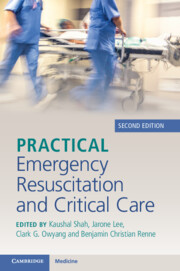Book contents
- Practical Emergency Resuscitation and Critical Care
- Practical Emergency Resuscitation and Critical Care
- Copyright page
- Contents
- Contributors
- Preface
- Section 1 General Critical Care
- Section 2 Infectious Disease Emergencies
- 5 Covid-19
- 6 Sepsis and Septic Shock
- 7 Pneumonia
- 8 Meningitis and Encephalitis
- 9 Infective Endocarditis
- 10 Necrotizing Soft Tissue Infections
- 11 Complications of Human Immunodeficiency Virus (HIV) and Acquired Immunodeficiency Syndrome (AIDS)
- Section 3 Neurological Emergencies
- Section 4 Cardiovascular Emergencies
- Section 5 Respiratory Emergencies
- Section 6 Gastrointestinal Emergencies
- Section 7 Renal Emergencies
- Section 8 Hematology–Oncology Emergencies
- Section 9 Endocrine Emergencies
- Section 10 Environmental Emergencies
- Section 11 Trauma
- Section 12 End of Life
- Index
- References
6 - Sepsis and Septic Shock
from Section 2 - Infectious Disease Emergencies
Published online by Cambridge University Press: 02 November 2023
- Practical Emergency Resuscitation and Critical Care
- Practical Emergency Resuscitation and Critical Care
- Copyright page
- Contents
- Contributors
- Preface
- Section 1 General Critical Care
- Section 2 Infectious Disease Emergencies
- 5 Covid-19
- 6 Sepsis and Septic Shock
- 7 Pneumonia
- 8 Meningitis and Encephalitis
- 9 Infective Endocarditis
- 10 Necrotizing Soft Tissue Infections
- 11 Complications of Human Immunodeficiency Virus (HIV) and Acquired Immunodeficiency Syndrome (AIDS)
- Section 3 Neurological Emergencies
- Section 4 Cardiovascular Emergencies
- Section 5 Respiratory Emergencies
- Section 6 Gastrointestinal Emergencies
- Section 7 Renal Emergencies
- Section 8 Hematology–Oncology Emergencies
- Section 9 Endocrine Emergencies
- Section 10 Environmental Emergencies
- Section 11 Trauma
- Section 12 End of Life
- Index
- References
Summary
Sepsis is currently defined as life-threatening organ dysfunction caused by dysregulated host response to infection. Septic shock is sepsis with persistent hypotension requiring vasopressor to maintain mean arterial pressure (MAP) ≥ 65 mmHg and having a serum lactate > 2 mmol/dL despite adequate fluid resuscitation.
There is wide variation in test characteristics for screening scores such as systemic inflammatory response syndrome (SIRS), quick Sequential Organ Failure Assessment (qSOFA), National Early Warning Score (NEWS) and Modified Early Warning Score (MEWS). A qSOFA score of ≥ 2 or a change in SOFA score of ≥ 2 can promptly identify these patients; however, qSOFA is not recommended as a single screening tool over comparable scores such as SIRS, NEWS, or MEWS.
- Type
- Chapter
- Information
- Practical Emergency Resuscitation and Critical Care , pp. 58 - 62Publisher: Cambridge University PressPrint publication year: 2023



